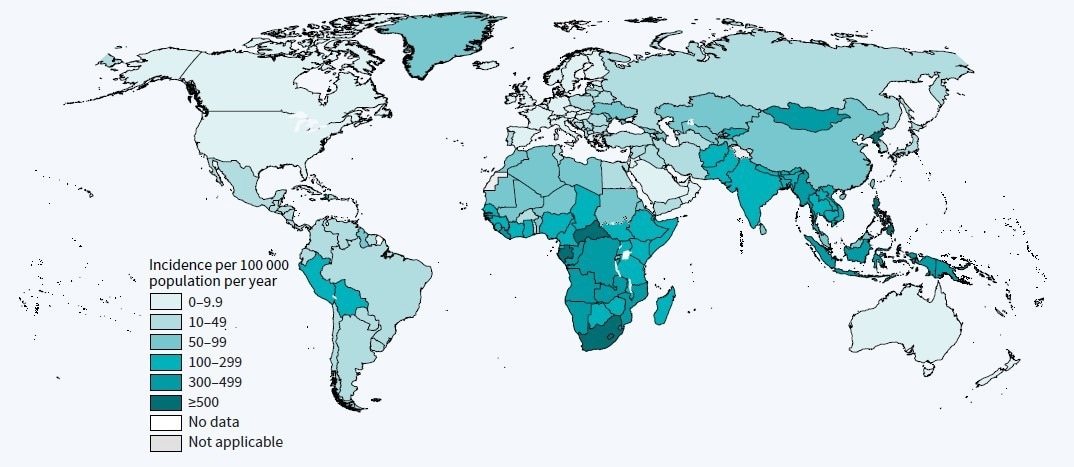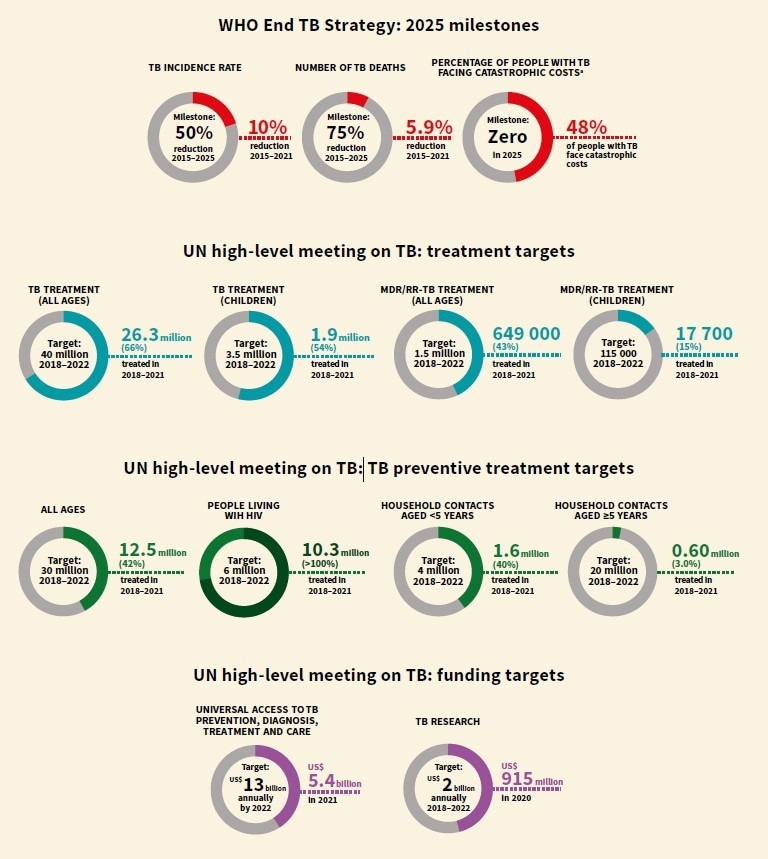Approximately 10 million people fall ill with tuberculosis (TB) each year. Even though TB is preventable and curable, over 1.5 million people die from it every year. The bacteria, Mycobacterium tuberculosis cause TB. TB primarily affects the lungs and can spread from an infected person who expels the bacteria into the air. Most people infected with TB are adults, with men being most affected (56.5%), followed by women (32.5%) and children (11%). The five common risk factors for TB include diabetes, smoking, undernutrition, alcohol use disorders, and HIV infection.
About 85% of individuals who develop TB can be cured using a 4 to 6-month drug regime. However, financial and economic barriers can impact access to healthcare for accurate diagnosis of TB and treatment completion. As a result, approximately half of the people with TB and their households suffer devastating costs due to TB disease. Although TB occurs worldwide, the highest burden is carried by 30 countries. Therefore, advances regarding universal health coverage (UHC), multisectoral action on broader TB determinants, and better social protection levels are essential to reduce the worldwide burden of TB disease.
 Global tuberculosis report 2022. Image Credit: Kateryna Kon / Shutterstock
Global tuberculosis report 2022. Image Credit: Kateryna Kon / Shutterstock
TB and the COVID-19 pandemic
According to the World Health Organization, about 10.6 million people got affected by TB in 2021, a 4.5% increase from 2020, and 1.6 million people died from TB. Additionally, the burden of drug-resistant TB (DR-TB) was observed to increase by 3% between 2020 and 2021. However, this is reportedly the first time that the number of people infected with TB and drug-resistant TB has increased.
Along with many healthcare services, TB services have also suffered disruption due to the COVID-19 pandemic resulting in severe consequences. Moreover, ongoing conflicts in the Middle East, Africa, and Eastern Europe have further worsened the situation for vulnerable populations. This resulted in the reduction of people diagnosed with TB and an increase in the number of people untreated with TB. The number of people diagnosed with TB was observed to fall from 7.1 million in 2019 to 5.8 million in 2020. Although a partial recovery was observed in 2021, it was still significantly below pre-pandemic levels. This led to an increase in the number of people developing TB, more community transmission, and an increase in TB deaths.
Additionally, the number of people receiving treatment for rifampicin-resistant TB (RR-TB) and multidrug-resistant TB (MDR-TB) was also observed to decrease between 2019 and 2020. The number of people reported to start treatment for RR-TB in 2021 was 161,746, about one-third of the people in need of treatment.
A new report published by the World Health Organization indicated a decrease in global spending on essential TB services from US$6 billion in 2019 to US$5.4 billion in 2021. Most of the funding used in 2021 came from domestic sources. However, in middle and low-income countries, international funding remains essential. The main source of global funds is the Global Fund to Fight AIDS, Tuberculosis, and Malaria (the Global Fund) which the United States Government is the largest contributor.
"If the pandemic has taught us anything, it’s that with solidarity, determination, innovation and the equitable use of tools, we can overcome severe health threats. Let’s apply those lessons to tuberculosis. It is time to put a stop to this long-time killer. Working together, we can end TB." Dr Tedros Adhanom Ghebreyesus Director-General World Health Organization

Estimated TB incidence rates, 2021
Small achievements
Amidst stalling progress, there are few successes. About 26.3 million people were reported to be treated for TB between 2018 to 2021 at the UN High-Level Meeting on TB. Out of the 30 highest-burden countries, Bangladesh, Zambia, China, Brazil, and Uganda were reported to be the countries with the highest levels of treatment coverage in 2021. Moreover, the number of people receiving TB preventive treatment was also reported to rebound in 2021, close to 2019 levels.

WHO End TB Strategy: 2025 milestones
Furthermore, more than 10 million people living with HIV were reported to receive TB preventive treatment in the last 4 years. Kenya, Namibia, the United Republic of Tanzania, Lesotho, Zambia, South Africa, and Ethiopia have been reported to surpass the 2020 milestone of a 20% reduction in the incidence of TB compared to 2015.
"The report provides important new evidence and makes a strong case for the need to join forces and urgently redouble efforts to get the TB response back on track to reach TB targets and save lives. It will be an essential resource for countries, partners and civil society in the lead up to the second UN high-level meeting on TB to be held in 2023." Dr Tereza Kasaeva Director WHO Global TB Programme
Many countries have also increased the uptake of new guidance and tools from WHO leading to early access to TB prevention and better outcomes. As a result, a 5% increase in the number of diagnosed with TB in 2021 as compared to 2020 has been observed. One hundred nine countries used all-oral longer regimens and 92 shorter regimens for the treatment of MDR/RR-TB in 2021. Additionally, there has been increased access to shorter rifamycin-based regimens for preventive TB treatment.
This report, therefore, indicates the urgent need for countries to restore access to essential TB services, increase investments, take multisectoral action to address determinants that impact TB epidemics and their socioeconomic effects, as well as improve new diagnostics, drugs, and vaccines to prevent severe cases of TB disease and deaths.